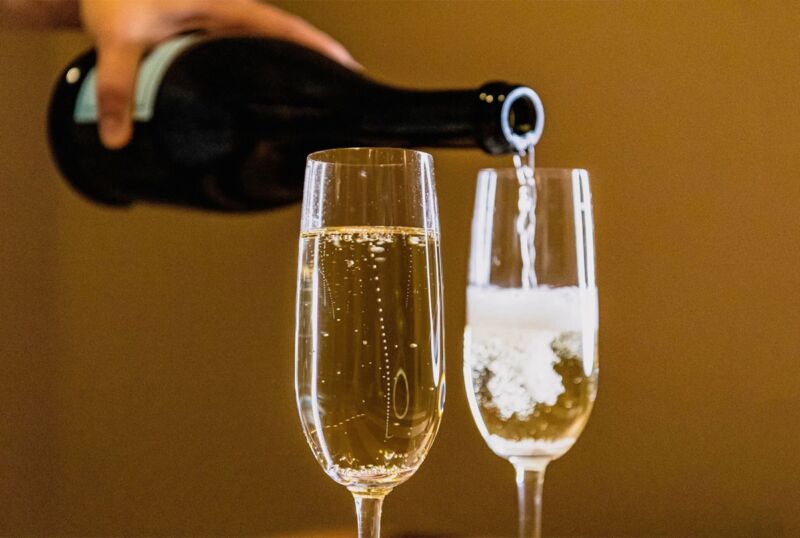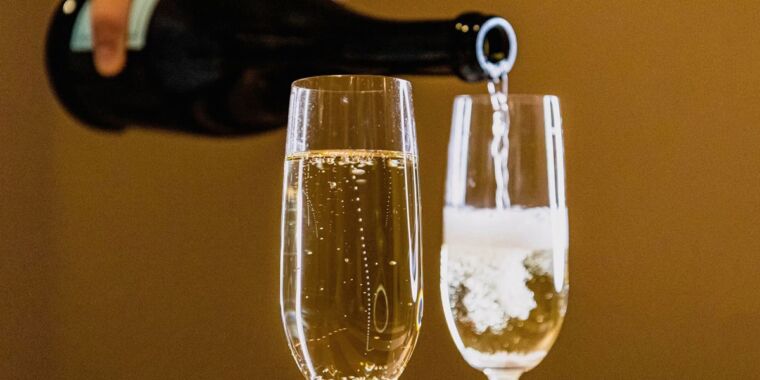
Madeline Federle and Colin Sullivan
Roberto Zenit, a physicist at Brown University, has a knack for linking his fundamental research into fluid dynamics to everyday phenomena, such as enjoying a glass of champagne with friends. He noticed one day that the bubbles rising to the surface form stable vertical columns, unlike other fizzy drinks, where the wake of rising bubbles pushes other bubbles sideways, so that several bubbles rise at the same time. Zenit found that this is because surfactant molecules coat the champagne bubbles and stimulate more vortices, disrupting the wake, according to a new paper published in the journal Physical Review Fluids.
“Just observing a glass of liquid supersaturated with carbon dioxide is like having a laboratory in front of you,” Zenit told Ars. “It’s a really good example of trying to understand hydrodynamic interactions. When two bubbles move in tandem, they usually get misaligned because they create a disturbance in the fluid around them. We realized this was very different for champagne If you know anything about bubble dynamics, that’s not natural, so of course we were immediately intrigued.”
Zenit has previously analyzed the fluid dynamics of modern painting techniques and materials developed by greats such as muralist David Siqueiros and Jackson Pollock, both of whom Zenit considers “intuitive physicists”. Siqueiros’ famous “accidental painting technique” involved pouring layers of paint onto a horizontal surface and allowing wisps, blobs, and other shapes to form over time. The trick is to place a dense liquid on top of a lighter liquid to create a classical instability because the heavier liquid will push through the lighter liquid. According to Zenit, Pollock’s dripping technique relied on the same instability to produce curled lines and smudges on his canvases.
Carbonation is another fascinating topic in fluid dynamics. As we previously reported, the effervescence of champagne comes from the nucleation of bubbles on the glass walls. Once they detach from their nucleation sites, the bubbles grow as they rise to the surface of the liquid and burst at the surface. This usually happens within a few milliseconds and the distinctive crackling sound is emitted as the bubbles burst. The bubbles “ring” at specific resonance frequencies depending on their size, so it’s possible to “hear” the size distribution of bubbles as they rise to the surface in a glass of champagne.
In 2021, physicists at the Sorbonne University in Paris investigated the connection between the fluid dynamics of the bursting bubbles and the crackling fizzing sounds in hopes of identifying the exact physical mechanism. The sound coincided with the bubble rupturing as it approached the surface, but part of the bubble remained submerged, generating acoustic vibrations at the liquid-gas interface, the frequency of which depended on the diameter of the hole in the bubble and the volume of the bell. gas in. So as the break gets bigger, the frequency increases in pitch until the bell “dies”.
Other studies have shown that when the bubbles burst in champagne, they produce droplets that release aromatic compounds believed to enhance the flavor. Larger bubbles promote the release of aerosols into the air above the glass – bubbles of the order of 1.7 mm at the surface. French physicist Gerard Liger-Belair of the University of Reims Champagne-Ardenne has shown with high-speed imaging that shock waves were created when a champagne cork was uncorked. He followed up in 2022 with computer simulations revealing that in the first millisecond after the cork pops, the ejected gas forms several types of shock waves — even reaching supersonic speeds and forming ring patterns known as shock diamonds — before the bubbles settle and are done . be swallowed.

